The Malaysian medical physics community celebrates International Medical Physics Week by series of webinars dedicated to various professional, educational and organizational aspects of Medical Physics.
All are welcome to join us to learn more about medical physicists, what we do, Malaysia's current status, and opportunities for research collaboration! The webinars are FREE! CPD points will be awarded for UMMC staff.
For further enquiry, please contact Pn Naja (najanajwa@ummc.edu.my) or Dr Jeannie Wong (jeannie.wong@ummc.edu.my)
E-certificate will be provided. Follow this link to register for the activities - http://bit.ly/3ty0Vty
Scroll down for the webinar links and the youtube links to the recorded sessions!
.jpg)
Online Forum on Allied Health Profession Act
Speakers:
Mr Saravanakumar A/L Maniam
Dr. Hafiz Mohd Zin
Dr Supriyanto Ardjo Pawiro
Moderator:
Dr. Ung Ngie Min
Participant Zoom Link: https://zoom.us/j/94886506896
|
Time |
Programme |
Speaker |
|
|
10.00 – 10.05 am |
Welcoming remarks |
Dr. Ung Ngie Min Clinical Oncology Unit, Faculty of Medicine, University of Malaya |
|
|
10.05 – 10.25 am |
The Allied Health Professions (AHP) Act 774 – Introduction and current status
|
Mr Saravanakumar A/L Maniam, MAHPC secretariat, Division of Allied Health Sciences MOH Malaysia
|
|
|
10.25 – 10.45 am |
The medical physics profession and the AHP Act 774 |
Dr Hafiz Mohd Zin, Council Member, Malaysian Allied Health Professions Council (MAHPC) |
|
|
10.45 – 11.05 am |
Medical Physicists registration -experience from Indonesia
|
Dr Supriyanto Ardjo Pawiro, Chairperson, Indonesian Association of Physicists in Medicine |
|
|
11.05 am – 11.30 am |
Q & A
|
All |
|
Webinar on International Medical Physics Certification Board (IMPCB) accreditation and certification
Speakers:
Dr Colin Orton
Dr Raymond Wu
Dr Tomas Kron
Dr Adel Mustafa
Moderator:
Dr. Jeannie Wong Hsiu Ding
Participant Zoom Link: https://zoom.us/j/99733936792
|
Time |
Programme |
Speaker |
|
9.00 – 9.05 am (MYT) |
Welcoming Remark |
Dr Jeannie Wong Dept of Biomedical Imaging, Faculty of Medicine, University of Malaya |
|
9.05 – 9.20 am (MYT) |
The importance of certification |
Dr Colin Orton President and Chair of IMPBC Board of Director |
|
9.20 – 9.35 am (MYT) |
IMPCB: the concept and its realisation |
Dr Raymond Wu Chief Executive Officer |
|
9.35 – 9.45 am (MYT) |
The first 10 years and a few thoughts on the future |
Dr Tomas Kron Nomination And Election Committee |
|
9.45 – 10.05 am (MYT) |
Nuts and bolts: how IMPCB work |
Dr Adel Mustafa Chief Examiner and Chair of Accreditation Committee |
|
10.05 – 10.30 am (MYT) |
Panel discussion
|
All |
9 am – 10.30 am (Malaysia) @ 11 am – 1 pm (Melbourne) @ 26/4/2021 9 pm (NY) 6 pm (LA). Malaysia is GMT+8.
Medical Physicists – Roles and Current Issues
Speakers:
Ms. Woon Yea Lee
Pn. Azleen Mohd. Zain
Pn. Aminah Mohamad
Dr. Bidi Ab. Hamid
Moderator:
Ms. Sharizan Shaharuddin
Participant Zoom Link: https://zoom.us/j/93198197028
|
Time |
Programme |
Speaker |
|
10.00 – 10.05 am |
Welcoming remark |
Ms Sharizan Shaharuddin Senior Physicists, Medical Physics Unit, UMMC |
|
10.05 – 10.20 am |
Radiotherapy |
Ms. Woon Yea Lee Senior Physicists Sarawak General Hospital |
|
10.20 – 10.40 am |
Nuclear Medicine |
Pn. Azleen Mohd. Zain Head of Medical Physics Unit, UMMC |
|
10.40 – 11.10 am |
Diagnostic Radiology |
Pn. Aminah Mohamad Senior Physicist, Medical Physics Unit, UMMC |
|
11.10 – 11.30 am |
Regulatory |
Dr. Bidi Ab. Hamid Head of Registration Section, Medical Radiation Surveillance Division, Ministry of Health Malaysia. |
|
11.30 – 12.00 pm |
Q & A
|
All |
Medical Physics Research Collaboration
Medical physics is the branch of applied physics in the field of medicine, in particular for the diagnosis and therapeutic purposes. Medical physicist (MP) plays a vital role in the healthcare system including in the development of new technologies that have revolutionised the way medicine is practised. This session aims to share current updates on the research activities and foster multi-institutional collaboration of medical physicists in Malaysia. It covers the current research focuses, initiatives and opportunities related to medical physics in the Ministry of Health, public and private universities. It also addresses the limitations and challenges faced by the medical physicists while engaging all stakeholders to fill the gap through collaborations.
Speakers:
A/P Dr Jeannie Wong
A/P Dr Yeong Chai Hong
Dr Norizan bt Rosli
Dr Ng Aik Hao
Ms Pearl Cheah
Moderator:
Dr Azlan Che Ahmad
Participant Zoom Link: https://zoom.us/j/96765250262
|
Time |
Programme |
Speaker |
|
10.00 – 10.05 am |
Welcoming Remark |
Dr Azlan Che Ahmad Dept of Biomedical Imaging, Faculty of Medicine, University of Malaya |
|
10.05 – 10.15 am |
Medical physics research opportunities and challenges-from public university perspectives |
A/P Dr Jeannie Wong Dept of Biomedical Imaging, Faculty of Medicine, University of Malaya |
|
10.15 – 10.25 am |
Medical physics research opportunities and challenges-from private university perspectives |
A/P Dr Yeong Chai Hong School of Medicine Faculty of Health and Medical Sciences Taylor's University |
|
10.25 – 10.35 am |
Ministry of Health (MOH) research initiatives and requirements |
Dr Norizan bt Rosli Head of Coordination Centre for Clinical Research Network, Institute of Clinical Research Centre, NIH |
|
10.35 – 10.45 am |
MOH Medical Physics Research Task Force |
Dr Ng Aik Hao Chair of the MOH MP Research Task Force |
|
10.45 – 10.55 am |
Industrial supports in Medical Physics research |
Ms Pearl Cheah Physics & Application Manager Transmedic Group |
|
10.55 – 11.30 am |
Panel Discussion |
All |
As part of the IMPW 2021, the Master of Medical Physics students interviewed a few medical physicists in the quest to understand their life and work in this profession. We hope to inspire more young people to be interested to become medical physicist. We also thank the wonderful medical physicists who had willingly shared their experience with us.
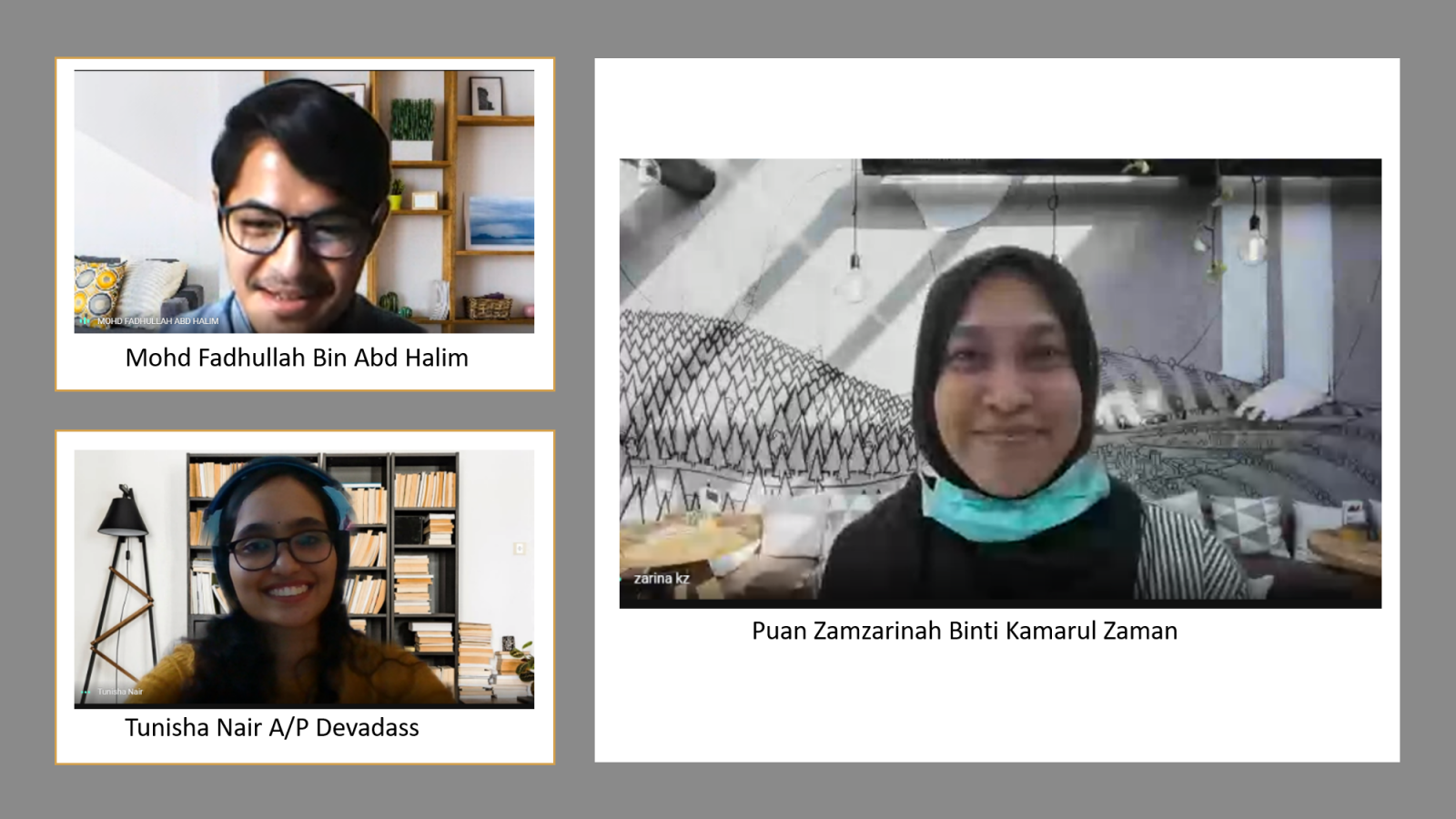
Puan Zamzarinah Binti Kamarul Zaman is an accomplished senior Medical Physicist at the Medical Physics Unit, Department of Clinical Oncology, University of Malaya Medical Centre (UMMC). She has been working in UMMC for almost 17 years, focusing mainly on radiation therapy until today. It takes a lot of dedication and hard work to reach the top of one’s profession, and it is no doubt that Puan Zamzarinah had equipped herself with all of these qualities, which made her successful in this field today.
Puan Zamzarinah was born in Kuala Lumpur, Malaysia, on April 19, 1978. She obtained her primary education at Sekolah Rendah Convent Sentul 1, Kuala Lumpur since 1985 and finished her secondary education in 1995 at Sekolah Menengah Convent Sentul, Kuala Lumpur. Her education did not stop here. With a strong heart and patience, she graduated from the Universiti Kebangsaan Malaysia in Bangi, Selangor, with a Bachelor of Science in Physics in 2001. After receiving her education, she started her first career in the same year at the Radiology Department in UMMC. She was then assigned to the Oncology Department in 2008. From there, she maintains her career projection actively in radiation therapy until now. She later completed her master’s degree in Medical Physics. She published her first thesis entitled “In-Vivo Bladder and Rectal Dose Measurement During High Dose Rate (HDR) Brachytherapy of Cervical Cancer Using Co-60 Multisource” in 2013. During her tenure, she gained valuable knowledge and refined her skills as a reputable medical physicist primarily through on-job training and assignments. Her interest in radiotherapy is grounded by her passion for treatment planning, which allows her to be creative to do the treatment plan and the engaging working environment through an excellent multidisciplinary team, which has captured her heart deeply.
As an active medical physicist, by attending conferences, training and meetings, Puan Zamzarinah engages in several work attachments with the government sectors and/or private agencies such as Hospital Kuala Lumpur, where she shares her knowledge and experience on state-of-the-art radiation therapy technologies used by the UMMC. Her day-to-day working routine starts by checking her e-mails in the morning to ensure that no tasks related to radiation therapy will be missed unintentionally, and she will always remind her subordinates, of the standard operating procedures that need to be followed by everyone, due to the recent COVID-19 pandemic spurt, before starting their daily duty routine. Once her morning’s housekeeping reminder is completed, she will take her time to do rounds to ensure that there is no problem with the modalities, to ensure a smooth workflow. Every Monday, Puan Zamzarinah performs the Winston-Lutz (WL) test as part of the quality assurance (QA) procedure before the stereotactic radiosurgery (SRS) treatments since she is in charge of the modality that treats for SRS cases. She added that the WL test is a well-described procedure developed to verify the Linac isocenter measurements to establish clinically meaningful thresholds. Lastly, she will head to the treatment planning room to assist her colleagues in accomplishing the plans that need to be completed. During specified weekends, she will spend her time with her team to perform quality control procedures that require consistent assessment weekly, monthly, and annually. Apart from that, she often uses her weekends to do her research or to spend her priceless weekends with her beloved family. It is truly indisputable that Puan Zamzarinah has an amazing healthy work-life balance, where she knows how to separate her personal and professional lives appropriately.
Being a Medical Physicist, she could not deny that she faced many obstacles along her career path. One of them involves going through a hard time previously on the communication breakdown; her first advice is how crucial good workplace communication among the medical physicists is to build great teamwork in achieving better workplace alignment. She also emphasized eliminating the senior-junior mentality, which is essential to achieve productivity and strong working relationships at all levels at the workplace. She added that healthy competition could also be felt when UMMC competes with the government’s medical physicists to attend overseas’ training and conferences. Even most of the opportunities were not on her side, but she never felt shattered. Instead, she embraces other alternatives in gaining knowledge and seizes any opportunities coming ahead. During her career, hurdles such as delayed QA implementation due to back-to-back treatment schedules caused by shareable modalities with other private wings of UMMC or last-minute changes on the treatment plan can never be avoided. However, Puan Zamzarinah and her team will use every opportunity to maintain the quality standard in delivering their professional services to the patients.
Advising the future Medical Physicist, Puan Zamzarinah recommended that all young juniors should grab the opportunity to spend time to handle and run the modalities physically, rather than observing them through recorded screens. The juniors will see how complex and advanced the modalities are from this hands-on activity, experiencing how to rotate the Linac gantry using the remote console. Mastering the modality functions with own hands and preparing the treatment plan is crucial in becoming a medical physicist, allowing the juniors to experiment, learn from mistakes and understand the potential gaps between theory and practice. She also added that the juniors should not be shy to ask if there is any unclear situation or curiosity about the seniors' decision. This not only will help themselves out, but they will be helping those around them by raising questions as well. It is also handy if the juniors possess good computer literacy to write their own programming scripts and run the program effortlessly. Above all, she also highlighted the importance of having excellent soft skills, which can portray their work ethic, attitude, communication skills, and emotional intelligence that attribute to career success in this field.
Moreover, she stressed the need to be confident when facing the oncologists and doctors, which will help the medical physicists feel ready for life’s experiences, especially when things do not work out initially as confidence will help us not give up. Less confidence means less knowledge; therefore, the juniors need confidence as well as knowledge. She emphasized constantly updating themselves with the latest and advanced technology used in radiotherapy by reading published papers as this can help them be confident and conversant. With this, everybody can entrust your ability and have worth on your efforts.
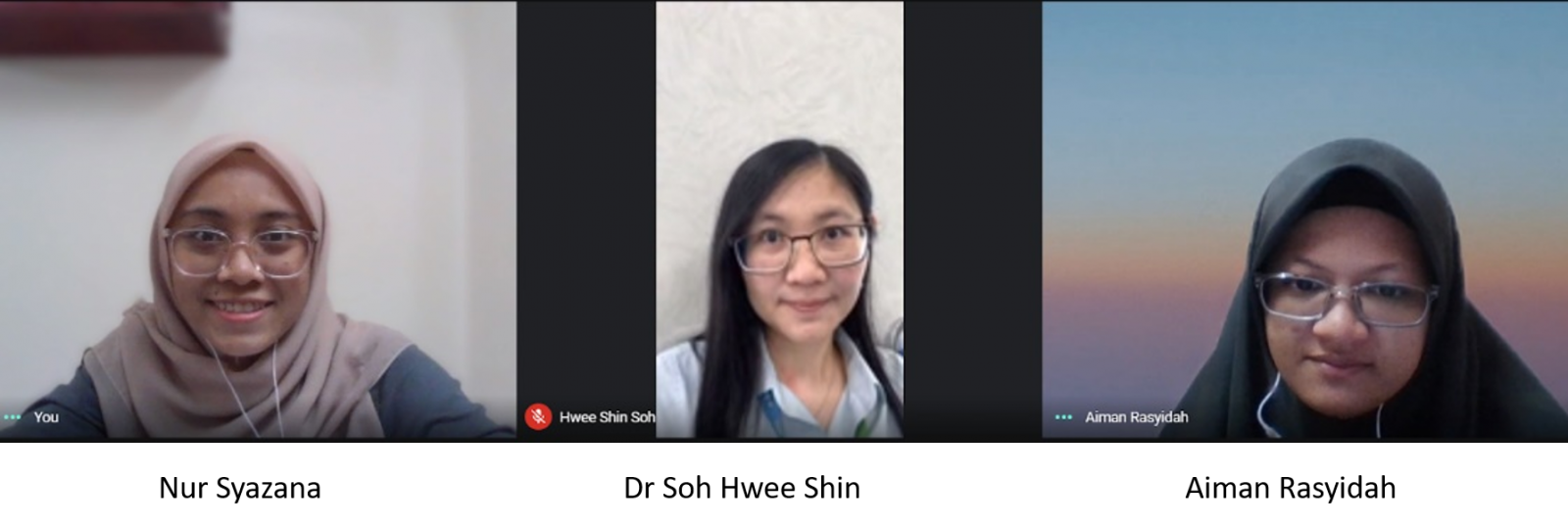
On 9th April 2021, we had interviewed Dr. Soh Hwee Shin, a senior of Master of Medical Physics that works in the Medical Radiation Surveillance Division at the Ministry of Health (MOH) as a part of activities for the International Medical Physics Week. She is currently working as senior assistant director at MOH as a part of the Medical Radiation Surveillance Division. After graduating with a degree in health physics at the Universiti Teknologi Malaysia (UTM) she continued her master of medical physics at Universiti Malaya (UM). She chose to pursue the Master of Medical Physics as she was more interested to learn more about physics in medicine. By acknowledging the existence of this program, she hopes to gain clinical knowledge and clinical experience.
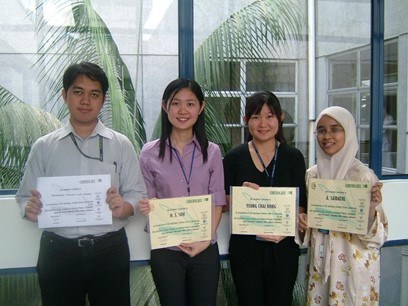
Dr Soh won the best poster award 2006 SEACOMP during her master study in UM.
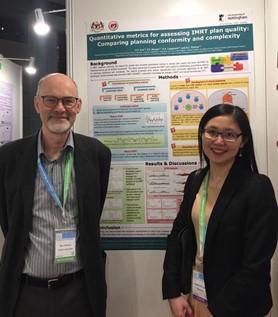
Best poster award in SEACOMP 2018. Standing next to her is Prof Alan Perkins, her supervisor from the University of Nottingham
After one year and a half of experience working as a medical physicist in the radiation oncology department in Universiti Kebangsaan Malaysia (UKM) Medical Centre, she got an offer from the MOH in 2009. At the beginning of her service in MOH, she handles the licensing job, enforcement task, and a bit of policy-making. After five years of work with MOH, she got an opportunity to continue her PhD at the University of Nottingham, United Kingdom, with a scholarship from MOH. After completed study in 2018, she joins the medical radiation surveillance team mainly in policymaking, providing clinical advice and consultation for medical physicists in hospitals and clinics. Last year, she was placed again under the licensing section, and currently, she is a part of the prosecution section.
When asked about the challenges of this job, Dr. Soh explained that they need to keep themselves up to date with the latest technology. This is because the development of regulation and the act was far behind compared with the advancement of technology. Moreover, the techniques they use keep developing and modernize. In consequence, a previous recommendation of regulation is outdated. Dr. Soh continued, as a part of the regulatory body, to keep up to date with the advancement of the technology applied nowadays. That is the biggest challenge as they need to review the regulations regularly to meet the current requirement of the technology.
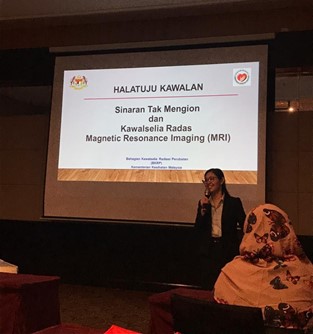
Dr Soh giving a talk as an MOH representative in an MRI safety course.
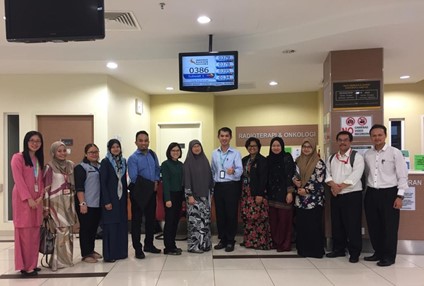
Joining MOH Medical Physics Research Task Force 2019-2020.
Dr. Soh thought that the master of medical physics is a bonus for becoming a medical physicist. However, what is most important is coming from ourselves, never give up, to keep learning from the experiences. When asking about the attitude, a young medical physicist should have, Dr. Soh emphasized one more time that willingness to keep learning something new is important. At the same time, keep improving ourselves from the experiences we gain. Last but not least, Dr. Soh advised the juniors that passion is the key to success. She reminded us to always equip ourselves with the knowledge and passion for the job to enjoy doing it to the very best.
Reported by Nishta A/P Letchumanan and Koh Zheng Hwee
Ms Sim Gek Suang graduated in 1999 from University Kebangsaan Malaysia (UKM) and worked as a junior medical physicist in Mahkota Medical Centre, Melacca, for two years. This mark the beginning of her career as a medical physicist. After 2 years of experience being a junior medical physicist, she embarked on her new career path in Pantai Hospital Ayer Keroh, Melacca, until the present time. At the beginning of her career in Hospital Pantai Ayer Keroh, she had the opportunity to be involved in the commissioning of the linac machine, which had been a great experience since this is her first attempt in commissioning and testing aiding by the senior medical physicist. In 2011, her consultant oncologist had encouraged her to pursue Masters Degree in Medical Physics. Due to the encouragement, she had soon enrolled and took on the challenge and completed her master degree in medical physics. She has completed her research project supervised by Associate Prof. Jeannie and had learnt a lot from the Master of Medical Physics programme at the University of Malaya. She is now working as a medical physicist in Hospital Pantai Ayer Keroh for 20 years.
Medical physics is the application of physics in medicine which Ms Sim had reviewed to be quite complicated. Medical physics has a broad scope covering many fields, such as radiotherapy, diagnostic imaging, and nuclear medicine. Radiobiology is vital as well in medical physics to enable the creation of good treatment planning.
As a senior medical physicist in the radiotherapy department, the role of a medical physicist is to perform daily Quality control (QC), checks and warm-up of the machine. The medical physicist is in charge of calibrating the sources and machine. Furthermore, in a private hospital, a medical physicist is given a role in the contouring process of treatment planning. Hence, more extensive knowledge in human anatomy, tumour localization and target volume is required. However, the senior physicist will need to carry out more administrative work instead of clinical work. Administrative work such as policy development for the department, staff issues, machine problem, liaise with the vendor and upgrading the machine are part of the responsibility as a senior medical physicist. For example, to purchase a radiotherapy machine, extensive research is required to study the specification, price and brand while comparing the advantages and disadvantages of the machine and companies. Hence, being a medical physicist is not only confine to clinical work. Due to the overwhelming administrative task, the junior physicists will be mainly in charge of treatment planning. Nevertheless, it is vital to practice and be involved in QC and treatment planning from time to time to ensure that skills are not lost. Moreover, the physicist must be able to do simple troubleshooting procedure such as failure to export images.
Ms Sim venture into this field due to the final year project in bachelor degree while working on research related to medical physics. After the final project, she had developed a passion for medical physics. She had shared her experience where she went to Mahkota Medical Centre to interview one of the medical physicists. After that, she was inspired to join the medical physicist team in Hospital Mahkota. Moreover, Ms Sim had shown a better affection in the field of radiotherapy among the treatment methods.
Ms Sim is currently attached in Pantai Ayer Keroh, Melaka as a senior medical physicist. The organisation provides advanced technologies such as advanced linear accelerator, volumetric modulated arc therapy, image-guided radiation therapy and brachytherapy.
1.6 Medical physicist in diagnostic imaging
Based on Ms Sim, the radiotherapy department needs medical physicists more than the diagnostic imaging department. The Ministry of Health will check private centre every year. Currently, the government does not enforce medical physicist to work in the diagnostic department. However, in radiotherapy, a medical physicist is required. A medical physicist is crucial in calibrating the sources and machine in radiotherapy. In the diagnostic imaging department, QA and QC are mostly carried out by the engineers and suppliers.
The daily routine of a medical physicist would never be a consistent one. Physicists usually will have to calibrate the sources and calibrate the machines. In diagnostic areas, one should carry out quality analysis, quality control assessments, the daily warm-up of machines and daily quality control checks. Medical physicists also rotate with radiographers, radiation therapist to carry out the daily checks. Treatment planning systems are also done by medical physicists, in most cases. Hence, constant reading and gaining knowledge in radiobiology and anatomy play an integral part in becoming a good medical physicist, suggested by Ms. Sim. Communication with the medical doctors is also a routine for a medical physicist. Discussion on treatment plans is often done to be on the same page while treating a patient.
As the job designation of medical physicists gets higher in the organisation’s hierarchy, the workload shifts more to administrative work than clinical work. They have to be the person in charge to order machines, policy development of the department, staffs’ issues, communicating with machine vendors, study the specifications and price of a machine before buying a machine, carry out paperwork, supervise other medical physicists and many more. This is essentially true for at least private hospitals. Moreover, senior medical physicists often become consultants and must be willing to educate and share their knowledge with young medical physicists.
When Ms.Sim was asked about her pride as a medical physicist, she, with a graceful smile, replied that “You should be proud in whatever field you are into, even the simplest jobs.” She continued, “However, medical physics is something ‘rare’. It is not known widely among the public. As for myself, when I explain my job specifications to my friends or acquaintances who are not in this field, they simply replied, ‘Wow! That’s very special!’ Their replies made me feel very proud of my job as a medical physicist. When the patients ask, who am I? Am I a doctor? I simply replied, ‘you can call me a Dr when I obtain my PhD, but I am a medical physicist, and I work closely with the oncologist to help them treat you”. Ms Sim is very proud of her job, which is not merely a job but a medium to serve the ones who need care the most.
The major challenge faced by junior medical physicists is to become a good medical physicist. Often, a junior medical physicist is fresh graduates, and hence they are lack hands-on experience. Consequently, their level of self-confidence is also low, where they are usually reluctant to speak up to physicians or seek help. Thinking of the younger medical physicists must be further, rather than depending on the seniors for all the tasks assigned. It also takes time to understand that theory and hands-on experience are way too different when treating patients. Hence, Ms Sim’s advice to young medical physicist is that they should always be open to knowledge and communicate with doctors to gain more information. They should also be willing to have a wide connection among other medical physicists or colleagues from various institutions to exchange knowledge and ideas. The sharing of knowledge should always be two-way, she added.
Moreover, initiative and extra effort to gain more knowledge are also very important, according to Ms Sim. Getting a treatment planning system being approved by the doctor, for IMRT cases, for example, is not the end of the story. Extra improvement can and should be made to obtain profound knowledge on the case and the whole procedure.
Medical physicists’ future is not only restricted to clinical medical physicists working in the hospital. They can also venture into research fields, become academicians, application specialists and consultants in various part of the world. This is because the number of cancer patients increases while patients are being diagnosed at a younger age. Cancer is faced by people from all walks of life, regardless of their age in these years. More cancer treatment/radiotherapy treatment centres are being launched to handle the situations.
Getting a job in this field should not be a problem due to these above-mentioned reasons. However, Ms Sim advice us to obtain some clinical experiences or attachments to get a clear picture of how this field of expertise is operated. For example, to become an application specialist, clinical knowledge is a must to understand a user's needs. On the other hand, to become a consultant, the ministry set up a requirement to have a Class H license to carry out quality analysis and quality control assessments and certify the machines brought into the country.
Work-life balance entirely depends on an individual. As for Ms Sim, she can manage her time well between work and life. She also mentioned that her workload is manageable, and since she can work in a fast manner, she can eloquently manage time for work and family. If one can settle all the cases in a day by 5 p.m, you are free to go home, she added.
Apart from that, one can also work on the cases remotely, once or twice a week if they think they should do so. Due to technological advancements, this option is possible to be done. As long as the done is work is done, it should be fine, said Ms.Sim.